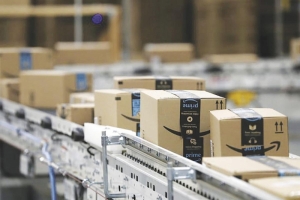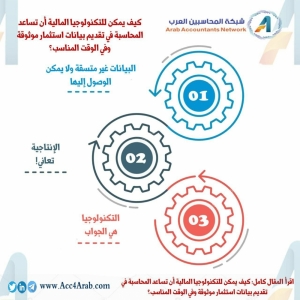عرض العناصر حسب علامة : ضرائب
الثلاثاء, 24 مايو 2022 12:36
رسالة ماجستير الاعتراضات الضريبية أسبابها وسبل معالجتها من وجهة نظر كل من دائرة ضريبة الدخل والمكلفين
هدفت هذه الدراسة إلى تحديد الأسباب الكامنة وراء الاعتراضات الضريبية، وتحديد المعوقات التي تحول دون حل تلك الأسباب، واقتراح السبل الكفيلة لمعالجة تلك المعوقات.
نشر في
رسائل ماجستير و دكتوراة
موسومة تحت
الأحد, 28 نوفمبر 2021 19:40
لن تحل الأتمتة محل المحاسب القانوني
معلومات إضافية
-
المحتوى بالإنجليزية
Automation won’t replace CPAs. It will enhance them
By Snehal Shinde
November 24, 2021, 10:36 a.m. EST
4 Min Read
Facebook
Twitter
LinkedIn
Email
Show more sharing options
Artificial intelligence is going to change accounting, but not in the ways that you think.
By now, AI is being utilized in almost every industry. While in some sectors automation could lead to a reduction in the number of jobs, for accountants, its impact is beneficial. If you’re a practicing CPA, rest easy; technology isn’t coming here to take your job, it’s here to make your job better.
Like the previous adoption of calculators or online bookkeeping services, the industry, and those who serve in it, are safe. People still provide what technology and algorithms can’t, particularly trust and client interactions. But technology and algorithms can replace much of the work that no one enjoys doing, while simultaneously freeing up CPAs to become better partners to the organizations they work with.
Streamline the collection process of organizer information with SafeSend Organizers™
Introducing a new optional feature within the award winning SafeSend Suite that automates the front end of the tax engagement
SPONSOR CONTENT FROM SAFESEND
Eliminating the mundane
Whether you’re an accountant just starting out or higher up the ladder, you know that many of the tasks for a new accountant are repetitive and boring. But they need to be done. Items like data entry, reconciliation, adjusting entries and categorizing expenses have long been the responsibilities and bane of the newly employed accountant. Few, if any, enjoy this work.
AI in accounting is significantly reducing — and in some cases eliminating — these tasks. That doesn’t mean less experienced accountants are now replaceable. A person is still needed to verify there are no unintended errors in the data. Someone still needs to make sense of and explain all the data. It means less copy and paste during your workday, not a reduction in hours.
Increased accuracy and efficiency
Many repetitive tasks are prone to human error. When you’re plugging in data all day, it’s understandable: Sometimes a keystroke is missed or an item gets duplicated or put on the wrong line in a spreadsheet. Automating these tasks actually increases the accuracy of reports, while drastically reducing the amount of time necessary to compile them.
Imagine spending an hour each day to verify the numbers, rather than four hours just plugging numbers in. Month-end closing reports can take a couple of hours to analyze rather than 20 to compile. When this type of work is automated, it allows accountants to focus on other types of work, often more creative and strategic.
More, happier clients
Increased efficiency and accuracy have trickle-down effects that boost your bottom line. Accounting practices are limited in the number of clients they can take on based on the amount of time required to input data and create reports. Accountants know there’s no shortage of people looking for their skill sets. With the mundane and time-consuming tasks out of the way, you can actually increase your client base.
It also means you can give more time to each client. Rather than emails piling up and having clients beating down the door to get information and reports, you’ll be able to respond and provide them with what they need quickly. This also allows you to talk to them about more strategic concerns like spend and income rates, trends across periods, and suggestions for future actions. Combine this level of service with more accurate reports and you’ve drastically improved client relationships at the same time you’re taking on additional business.
Less stress at tax time
April and the months leading up to it can seem like an endless pile of receipts, forms, spreadsheets and transactions to categorize to prepare taxes. AI can help with all of that. We’ve already talked about the ability of AI to eliminate data entry and perform reconciliation, but it can do even more than that at tax time.
Automation can ensure that not only are all of the numbers compiled accurately, but the information is optimized for tax purposes. In the future, it will also be able to scan for any available tax credits and integrate with the IRS submission portal.
Accountants and tax professionals will still be needed at tax time, because a human will still need to verify that the numbers make sense and double-check that the technology did its job correctly. They’ll just be able to take on more clients, achieve a bit more balance, and get a better night’s rest during crunch time.
Trust still comes from humans
Automation isn’t here to replace accountants. In fact, AI in accounting is designed to benefit from humans, rather than being standalone. It will shift the nature of your daily tasks, with junior accountants performing more strategic, creative work and senior accountants having more client interaction. In the end, the financial professionals that we work with are more than happy with these changes.
Financial professionals are increasingly relying on technology to help run their practices and perform their duties. The breadth of continuing professional education courses that teach tech solutions is evidence of this. AI is at the forefront of new technology for the industry, and adopting it early will give you an advantage as the industry and client expectations shift. - البلد الأردن
نشر في
تكنولوجيا المعلومات
موسومة تحت
الأربعاء, 10 نوفمبر 2021 13:55
مصر.. الضرائب تطالب بإقرار ضريبي لمراكز الدروس الخصوصية.. تقرير شامل ومسؤول يوضح
نشر في
ضرائب
موسومة تحت
الخميس, 16 سبتمبر 2021 10:08
أمازون والضرائب العالمية
معلومات إضافية
-
المحتوى بالإنجليزية
A U.S.-driven effort to reach a global accord on taxing big tech companies’ overseas profits is getting bogged down over ensnaring one firm in particular: Amazon.com Inc.
A Treasury Department proposal, which was distributed to other governments earlier this month and has been seen by Bloomberg, would subject about 100 of the largest and most profitable companies to greater taxation in countries where the firms’ users and consumers are located, as opposed to the countries where they’re headquartered.
The idea is that the new rules would apply to any large companies that exceed certain numbers, yet to be determined, for their annual revenue and profit margin. Before Treasury Secretary Janet Yellen this month jump-started efforts that the Trump administration had opposed, the talks focused on digital and “consumer-facing” businesses — definitions countries had struggled to reach agreement on.
An employee takes a package from the conveyor belt at an Amazon.com Inc. fulfillment center in Kegworth, U.K.Chris Ratcliffe/Bloomberg
The global talks, led by the Organization for Economic Cooperation and Development, are trying to address many countries’ concerns that tech giants — and other multinationals — aren’t being properly taxed under the current system of rules. The OECD effort seeks to replace the digital services taxes a growing number of countries are enacting to capture more revenue from companies like Google, Facebook and Amazon.
But Amazon’s unusual status as a low-margin tech giant is emerging as a sticking point in negotiations. Seattle-based Amazon recently reported a global operating margin across its businesses of 5.5 percent; that compares with Facebook’s margin of 45.5 percent and 27.5 percent at Google parent Alphabet Inc.
The U.S. proposal called for including only “the largest and most profitable” multinational corporations. It didn’t call for specific numbers, but both revenue and profitability thresholds would have to be set high to capture just 100 companies.
Two Italian government officials, speaking on condition of anonymity, said Amazon should be covered and there’s no reason why a global tax accord can’t capture companies with narrow profit margins but high revenue. Italy, the euro area’s third-biggest economy, has imposed a 3 percent tax on companies with overall revenue above 750 million euros ($903 million) and revenue from digital services in Italy above 5.5 million euros.
A European Commission spokesperson said Tuesday that while the U.S. proposal offers a “promising opportunity” for progress toward a deal, “we should not forget what the initial policy rationale was: a fairer taxation of the digital economy. It is essential that any proposal on the table also addresses this challenge.” A French finance ministry official said they are still examining the U.S. proposal to determine if it would cover all digital multinationals.
The U.S., however, has long opposed an agreement that singles out a particular slice of the economy, such as rules that only affect digital companies, and the new Treasury proposal is intended to make the plan’s scope more quantitative and objective.
U.S. officials are aware that other finance ministries are trying to get low-margin companies captured within the profitability threshold, according to people familiar with the matter, who said Amazon is the target of these discussions. The U.S. continues to oppose efforts to target any single company or sector, said the people, who asked not to be identified.
The U.S. Treasury and Paris-based OECD declined to comment. Amazon didn’t respond to a request for comment.
Not ‘discriminatory’
“We’ve made it very clear to our European counterparts that we will not support a tax that is discriminatory toward American companies,” Wally Adeyemo, the deputy Treasury secretary, said earlier this month on CNBC.
No matter how successful an accord might otherwise be in reshaping tax collection and satisfying calls for multinational firms to pay their fair share to governments, failing to apply it to Amazon — led by the world’s richest person, and a regular target for progressive U.S. lawmakers like Bernie Sanders and Elizabeth Warren over its low tax bill — would risk public opposition to ratification in the U.S. along with European nations.
“Ultimately, it must catch Amazon, otherwise it will be deemed a failure,” and countries might unilaterally introduce their own measures, said Tommaso Faccio, an official at the Independent Commission for the Reform of International Corporate Taxation, a group advocating for overhauling global taxes.
Negotiators are considering the U.S. pitch as nearly 140 countries work to find consensus on both the profit reallocation plan and a global minimum tax, and present it to Group of 20 finance ministers in early July. President Joe Biden recently proposed raising the U.S. minimum tax so the country can collect more revenue from multinational firms and help pay for a $2.25 trillion infrastructure and jobs package.
Business lines
Amazon CEO Jeff Bezos has consistently set low profit targets, preferring to invest in the business, which also reduces the company’s tax obligations. Amazon had 2020 sales of $386 billion, more than Facebook and Google combined, yet it paid less than either company in income taxes. Amazon’s retail business, which includes warehouses around the country and delivery services, costs more to operate than digital advertising businesses run by Google and Facebook.
One method under consideration for including Amazon in the rules would be to allow taxation on specific lines of business, rather than just companies as a whole, according to the people familiar with the matter. For example, if the rules considered the lucrative Amazon Web Services business — with an operating margin of 28 percent — separately from the company’s lower-margin retail arm, countries could still see some of the company’s profits reallocated.
While the U.S. isn’t completely opposed to targeting business lines, it prefers any such practice to be limited, the people said.
In public consultations on previous iterations of the OECD plan, companies have argued that business-line segmentation will become overly complex.
Or, negotiators could also find a different way of setting the revenue and profitability thresholds that does capture the company, Faccio said. That would also risk making the rules more convoluted, after the U.S. proposal sought to simplify what had become an overly complicated determination of which companies would be covered.
“The administration clearly saw the need to inject momentum,” and decided to limit the proposal’s scope in an attempt to get an overall agreement by July, said Alex Cobham, chief executive at the Tax Justice Network. “But the politics will look less smart if the most high-profile companies in terms of public concern about tax abuse turn out to be excluded.”
— With assistance from Spencer Soper, Laura Davison, William Horobin and Nico Grant
نشر في
موضوعات متنوعة
الخميس, 29 يوليو 2021 14:37
ارنست اند يونج EY تقوم بإنشاء حل blockchain للتحدي الضريبي العالمي
قامت EY، جنبًا إلى جنب مع ممثلي الحكومة والصناعة، بإنشاء حل بعيد المدى blockchain لمواجهة التحديات في عملية ضريبة الاستقطاع عبر الحدود.
معلومات إضافية
-
المحتوى بالإنجليزية
EY, together with government and industry representatives, have created a far-reaching blockchain solution to address challenges in the cross-border withholding tax process.
Currently, there are some inefficiencies and complexities with the international withholding tax process in relation to dividend distributions. The goal for TaxGrid is to address these and improve tax compliance to nearly real-time, benefiting investors, financial institutions and tax authorities alike.
“Blockchain technology as a remedy to the withholding tax challenge is no longer just a concept,” said Hank Prybylski, EY global vice chair of transformation, in a statement. “This project shows that in the near future, industry and governments may be able to reconcile legal and technical issues, flex to address disparate demands of taxpayers and tax authorities, and promote digital transformation.”
TaxGrid is also designed to help financial intermediaries coordinate the timely exchange of investor information across a network to meet contractual obligations and, potentially, regulatory requirements, while protecting confidential investor information.
The solution uses blockchain technology to automate, decentralize and share tax and financial information more securely between financial intermediaries and tax authorities by creating a kind of shared record book of all dividend transactions, to help with taxation of dividend income at the source. TaxGrid is built to simplify the process for obtaining the correct tax treatment while reducing governments’ exposure to fraud.
To safeguard data privacy and confidentiality, the TaxGrid uses privacy technology to help protect investors’ sensitive information and commercial confidentiality. Zero-knowledge proof is a key feature of blockchain technology, allowing one party to prove it knows a certain piece of information or value, without revealing the actual information.
TaxGrid was developed in collaboration with government tax authorities, including the United Kingdom's HM Revenue & Customs, the Netherlands Tax Authorities and Norway, along with companies including BNP Paribas Securities Services, Citibank, JP Morgan Securities Services, Northern Trust, APG Asset Management, PGGM Investments, and EY teams ,as well as two invited academic institutions: the Vienna University of Economics and Business, and the Tax Administration Research Center at the University of Exeter in the U.K.
نشر في
موضوعات متنوعة
موسومة تحت
الإثنين, 03 أكتوبر 2022 12:53
برايس ووترهاوس كوبرز تطرح تطبيقات الذكاء الاصطناعي الضريبية والمحاسبية
معلومات إضافية
-
المحتوى بالإنجليزية
PwC rolls out tax and accounting AI apps
By Michael Cohn
February 24, 2021, 5:40 p.m. EST
3 Min Read
Facebook
Twitter
LinkedIn
Email
Show more sharing options
PricewaterhouseCoopers is turning some of the digital tools it developed internally to train its staff into artificial intelligence products its clients can use in their finance departments.
The Big Four firm has packaged together the products it’s developed over the past three and a half years into a set of applications it calls Digital on Demand. They include apps for analyzing invoices for fraud, identifying cost reductions from credit card bills, and automatically reading and processing details from tax forms, invoices and other financial documents.
The online tools build on the ProEdge upskilling apps the firm showcased last fall for training employees (see story). That started with its own employees, but now PwC is rolling them out to clients, many of whom are working remotely during the pandemic.
Managing Your Firm in a Post-COVID World
Think beyond the pandemic with exclusive resources to help you build a thriving virtual practice.
SPONSORED BY INTUIT ACCOUNTANTS
“A couple of years ago, we started our digital journey at PwC, where we really said it’s not just about putting technology in our people’s hands, but we really have to digitally upskill our workforce,” said PwC Labs and tax technology leader Michael Shehab. “We’ve been on that journey for about three and a half to four years. As part of our digital upskilling journey, it was not our original intent, but we realized we had created a lot of intellectual property in technology. As we upskilled our employees, we realized the industry and communities needed a lot of upskilling as well.”
PwC tried to make the tools as usable and familiar as online shopping apps. The firm has now provided its clients with around 350 “digital accelerators” for various uses.
“Whether you’re in a controllership, internal audit, a tax function, a finance department, or a forecasting department, we believe we have created a digital accelerator that can drive additional productivity,” said Shehab. “In the process of driving productivity for our clients, you’re also learning the tool and learning the technology and you’re digitally upskilling.”
After testing out the digital accelerators internally until they’re mature, PwC markets them to its clients. “Within the tax space, we have many assets that extract information from tax forms,” said Robin Stein, director of PwC Labs. “PwC’s AI models are incorporated within Digital on Demand, so the user has the benefit of PwC’s investment in data scientists and annotating models, and extracting information from tax forms. There are a number of data workflows to think about on state and local tax calculations, and being able to calculate that on a state by state basis, where PwC has the domain knowledge and makes sure the business logic is up to date. The user would be able to come in and leverage that by just downloading the app and using it.”
The tools can help clients deal with state and local tax audits by extracting information from tax forms, legal documents and other sources. “You have the ability to really take the words and numbers off of a page, digitize them and analyze them,” said Shehab.
Clients can use the apps to assess the impact of recent tax and finance legislation like the CARES Act on their company. “There are a number of visualizations that will model out the impact of the changes in tax legislation,” said Stein. “That’s definitely of primary importance for clients right now.”
PwC clients are using the apps in various industries, including financial services and manufacturing, but tech clients have been using them the most. “The technology industry tends to be savvy, and they like modern-day tools like this, so we’ve had a lot of success with the technology industry,” said Shehab.
Corporate clients can use the tools for modeling the multinational provisions of the U.S. tax system. “At this point in time, we’re not focused on global taxes, but some of the international components that go into a U.S. tax return,” said Shehab.
So far, the Digital on Demand set of tools has attracted positive interest from clients since PwC made the apps available in December. “It’s been a pretty overwhelming response in the market in this post-COVID environment,” said Shehab. “We didn’t release it because of COVID, but everyone’s working virtually. Everyone’s concerned about how to continue to upskill their workers in this not-in-person environment, so this has hit very well. This really enables you to drive more productivity and in a very digital, virtual way.”
He sees Digital on Demand as a follow-up to the ProEdge digital training tools that PwC made available last fall and predicts that more of them will be coming in the future. “You’re going to see a pattern more and more from PwC that we’re taking all of our intellectual property and turning it into products and offerings to the market,” he said.
نشر في
تكنولوجيا المعلومات
الأربعاء, 03 فبراير 2021 09:56
المصلحة تحرص على مد جسور الثقة مع الجهاز المصرفي.
نشر في
ضرائب
موسومة تحت
الثلاثاء, 24 مايو 2022 07:23
إنفوجرافيك.. كيف يمكن للتكنولوجيا المالية أن تساعد المحاسبة في تقديم بيانات استثمار موثوقة وفي الوقت المناسب؟
نشر في
إنفوجرافيك
موسومة تحت
الثلاثاء, 29 ديسمبر 2020 10:11
رئيس ضرائب كي بي ام جي يخطط للعام المضطرب المقبل
يتوقع نائب رئيس الضرائب في KPMG، جريج إنجل، عامًا آخر من التغييرات المضطربة في الوظيفة الضريبية للشركة
نشر في
موضوعات متنوعة
موسومة تحت










